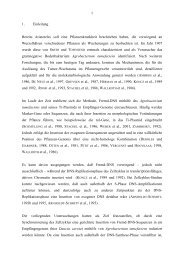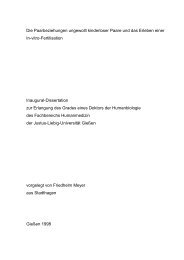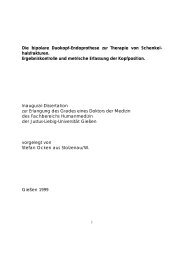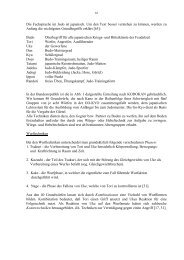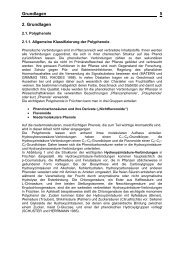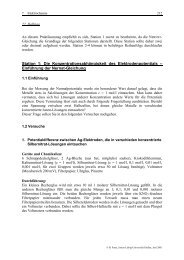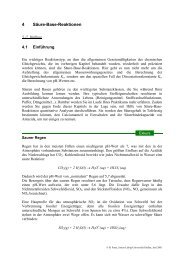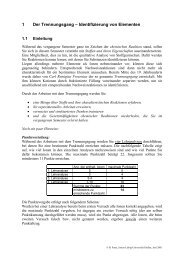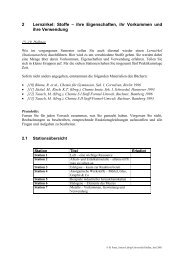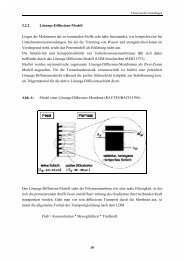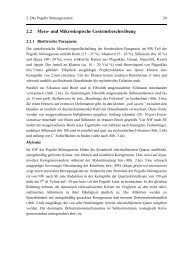Effects of diabaticity on fusion of heavy nuclei in the dinuclear model ...
Effects of diabaticity on fusion of heavy nuclei in the dinuclear model ...
Effects of diabaticity on fusion of heavy nuclei in the dinuclear model ...
You also want an ePaper? Increase the reach of your titles
YUMPU automatically turns print PDFs into web optimized ePapers that Google loves.
Chapter 8<br />
8.1 Summary<br />
Depend<strong>in</strong>g <strong>on</strong> <strong>the</strong> ma<strong>in</strong> degree <str<strong>on</strong>g>of</str<strong>on</strong>g> freedom used for <strong>the</strong> descripti<strong>on</strong> <str<strong>on</strong>g>of</str<strong>on</strong>g> fusi<strong>on</strong>, two different types<br />
<str<strong>on</strong>g>of</str<strong>on</strong>g> <strong>model</strong>s for fusi<strong>on</strong> can be dist<strong>in</strong>guished. The first type <str<strong>on</strong>g>of</str<strong>on</strong>g> <strong>model</strong>s assumes a melt<strong>in</strong>g <str<strong>on</strong>g>of</str<strong>on</strong>g> <strong>nuclei</strong><br />
al<strong>on</strong>g <strong>the</strong> <strong>in</strong>ternuclear distance (or el<strong>on</strong>gati<strong>on</strong> λ) [15, 16]. The sec<strong>on</strong>d type is <strong>the</strong> d<strong>in</strong>uclear<br />
system <strong>model</strong> [17, 34]. Models describ<strong>in</strong>g <strong>the</strong> fusi<strong>on</strong> process as an <strong>in</strong>ternuclear melt<strong>in</strong>g <str<strong>on</strong>g>of</str<strong>on</strong>g> nu-<br />
clei <str<strong>on</strong>g>of</str<strong>on</strong>g>ten use adiabatic potential energy surfaces. These potentials are calculated with <strong>the</strong><br />
macroscopic-microscopic method <str<strong>on</strong>g>of</str<strong>on</strong>g> <strong>the</strong> Strut<strong>in</strong>sky formalism. Without regard<strong>in</strong>g <strong>the</strong> competi-<br />
ti<strong>on</strong> between complete fusi<strong>on</strong> and quasi-fissi<strong>on</strong>, <strong>the</strong> first type <str<strong>on</strong>g>of</str<strong>on</strong>g> <strong>model</strong>s overestimates <strong>the</strong> fusi<strong>on</strong><br />
cross secti<strong>on</strong> <str<strong>on</strong>g>of</str<strong>on</strong>g> <strong>heavy</strong> <strong>nuclei</strong> [18]. However, <strong>the</strong> d<strong>in</strong>uclear system <strong>model</strong> describes <strong>the</strong> experi-<br />
mental fusi<strong>on</strong> data quite well. In this <strong>model</strong>, <strong>the</strong> fusi<strong>on</strong> process is c<strong>on</strong>sidered as <strong>the</strong> evoluti<strong>on</strong> <str<strong>on</strong>g>of</str<strong>on</strong>g><br />
a d<strong>in</strong>uclear system caused by <strong>the</strong> transfer <str<strong>on</strong>g>of</str<strong>on</strong>g> nucle<strong>on</strong>s from <strong>the</strong> light nucleus to <strong>the</strong> <strong>heavy</strong> <strong>on</strong>e.<br />
The d<strong>in</strong>uclear system c<strong>on</strong>sists <str<strong>on</strong>g>of</str<strong>on</strong>g> two touch<strong>in</strong>g <strong>nuclei</strong>, which c<strong>on</strong>serve <strong>the</strong>ir <strong>in</strong>dividuality, and<br />
evolves <strong>in</strong> <strong>the</strong> mass asymmetry η to a compound nucleus or decays <strong>in</strong> <strong>the</strong> el<strong>on</strong>gati<strong>on</strong> λ. The<br />
<strong>model</strong> assumes that <strong>the</strong> moti<strong>on</strong> <str<strong>on</strong>g>of</str<strong>on</strong>g> <strong>the</strong> d<strong>in</strong>uclear system to smaller el<strong>on</strong>gati<strong>on</strong>s λ is str<strong>on</strong>gly h<strong>in</strong>-<br />
dered. This is phenomenologically described with a double fold<strong>in</strong>g potential <strong>in</strong> frozen density<br />
approximati<strong>on</strong> which shows a m<strong>in</strong>imum near <strong>the</strong> touch<strong>in</strong>g c<strong>on</strong>figurati<strong>on</strong> <str<strong>on</strong>g>of</str<strong>on</strong>g> <strong>the</strong> <strong>nuclei</strong>.<br />
We have <strong>in</strong>vestigated <strong>the</strong> fusi<strong>on</strong> and quasi-fissi<strong>on</strong> process <str<strong>on</strong>g>of</str<strong>on</strong>g> <strong>heavy</strong> <strong>nuclei</strong> us<strong>in</strong>g <strong>the</strong> two-center<br />
shell <strong>model</strong> (TCSM). The diabatic potential energy surfaces as a functi<strong>on</strong> <str<strong>on</strong>g>of</str<strong>on</strong>g> <strong>the</strong> el<strong>on</strong>gati<strong>on</strong> λ,<br />
105



